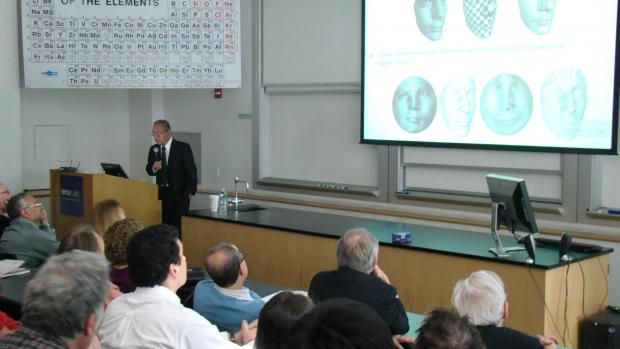Shing-Tung Yau, Eminent Mathematician, Gives Lecture

After a week of unseasonably chilly weather, last Friday afternoon was warm and sunny, with the weekend expected to bring more of the same. It was hard to guess how many would be drawn indoors for a lecture by mathematician Shing-Tung Yau. “It might be 20 people; it might be 200,” said Professor Deane Yang of NYU-Poly’s Department of Mathematics.
Turnout was closer to the latter. Faculty, students, and the general public (famed mathematician Louis Nirenberg was there) filled the lecture hall, with an overflow of guests crowding the room’s perimeter. Some perched on the ledge bordering one side of the hall, while others were content to stand and simply count themselves among the lucky. They were going to hear one of the greatest living mathematicians in the world, after all.
[GALLERY:3326|left]
Or so that’s how Professor Yang introduced Dr. Yau, chair of the mathematics department at Harvard University and recipient of the Fields Medal, MacArthur Fellowship, and Wolf Prize. Dr. Yau is best known, however, for proving the Calabi conjecture, which contributed the mathematical basis for string theory or the belief that 10-dimensional, vibrating strings construct the core of the universe.
“Everything is done of necessity,” Dr. Yau said, explaining the motivation behind his team’s latest research projects. “We needed data to do serious experiments.”
Those experiments centered on conformal geometry, the fundamental tool for surface imaging. Computer graphics, for instance, can maximize conformal geometry to render two-dimensional surfaces such as world maps and faces.
But the approach used by Dr. Yau and his team, which consists of 8-10 researchers, differs from traditional methods. “We use more pure mathematics,” he said.
His talk elaborated on that approach, with formulas and live demonstrations engaging the packed room. Dr. Yau also discussed the wide applicability of his research — how more realistic computer graphics might enhance educational games, for example, or how shape analysis that uses conformal models can assist researchers studying brain disease. He concluded his lecture on a stirring note, “We are expecting great revolutions in the continued interaction between pure mathematics and engineering.”




